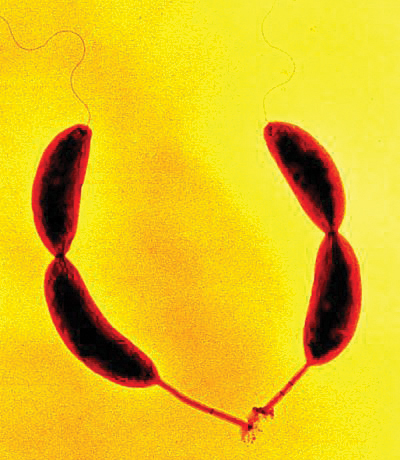Bacterial sphingolipids: Perhaps not as rare as we thought?
Among the ways cells adapt to changes in their environment, regulation of the lipidome is critical for maintaining cellular integrity. Species that lack temperature homeostasis adapt by modulating acyl chain saturation to resist changes in membrane fluidity. Bacteria such as Escherichia coli desaturate their fatty acids as temperatures decrease; the double bonds formed by acyl chain desaturation introduce kinks in the fatty acids that inhibit lipid packing and increase membrane fluidity to counteract the effects of lower temperature.
 Eric Klein’s lab showed that the Gram-negative aquatic bacterium Caulobacter crescentus synthesizes a novel glycosphingolipid when phosphates in its environment are limited.U.S. Department of Energy/Wikimedia Commons
Eric Klein’s lab showed that the Gram-negative aquatic bacterium Caulobacter crescentus synthesizes a novel glycosphingolipid when phosphates in its environment are limited.U.S. Department of Energy/Wikimedia Commons
Temperature is not the only environmental variable that necessitates membrane remodeling. In many settings, nutrient availability can vary widely. For example, nutrient levels in fresh-water lakes fluctuate with the seasons, and plant decomposition affects soil. In particular, oscillations in phosphate concentration can limit bacterial growth.
When phosphates are limited, the synthesis of membrane phospholipids becomes an obvious challenge. Studies have shown that alphaproteobacteria, such as and , adapt to phosphate starvation by increasing production of diacylglycerol-based glyceroglycolipids and ornithine lipids.
In our lab, that the Gram-negative aquatic bacterium Caulobacter crescentus responds to phosphate limitation by synthesizing a novel hexosyl-hexuronosyl-ceramide glycosphingolipid, or GSL. Ceramide-based GSLs are ubiquitous in eukaryotic organisms, but in bacteria they had been observed previously only in the Sphingomonadaceae family, where they function as a substitute for outer-membrane lipopolysaccharides, or LPS. Unlike Sphingomonas species, C. crescentus produces LPS even during phosphate starvation; in this organism, the GSLs appear to play a role in resistance to phage-mediated killing.
Now that we know that bacterial GSLs are not limited to just the Sphingomonadaceae, just how widespread are these lipid species? The honest answer is that we simply don’t know. While the lipidomes of many bacteria have been characterized, our findings in C. crescentus demonstrate that lipid abundance can vary with growth conditions. Indeed, previous characterizations in rich growth media did not identify GSLs in C. crescentus.
Another major challenge is that, unlike for eukaryotes, we do not know which enzymes are responsible for ceramide synthesis in prokaryotes. Only the enzyme that catalyzes the first step of ceramide synthesis, serine palmitoyltransferase, has clear homologues in bacteria as described in a . This implies that either (1) bacteria carry out the same synthetic chemistry as eukaryotes, but these enzymes diverged so long ago that the functionally equivalent proteins cannot be identified by sequence homology or (2) bacterial ceramide synthesis evolved independently using novel enzymes and/or synthetic pathways. If the genes required for ceramide synthesis are identified, researchers will be able to take a bioinformatic approach to finding additional species that might produce these lipids.
A growing body of work demonstrates that bacterially produced sphingolipids may play an important role in aspects of human health such as gut homeostasis and oral pathology. Uncovering the mechanism of prokaryotic ceramide synthesis will help determine how widespread these lipids are in bacteria and also may provide a novel route for pharmacological intervention.
Enjoy reading 91—«…´¥´√Ω Today?
Become a member to receive the print edition four times a year and the digital edition monthly.
Learn moreGet the latest from 91—«…´¥´√Ω Today
Enter your email address, and we’ll send you a weekly email with recent articles, interviews and more.
Latest in Science
Science highlights or most popular articles

Bacterial enzyme catalyzes body odor compound formation
Researchers identify a skin-resident Staphylococcus hominis dipeptidase involved in creating sulfur-containing secretions. Read more about this recent Journal of Biological Chemistry paper.

Neurobiology of stress and substance use
MOSAIC scholar and proud Latino, Bryan Cruz of Scripps Research Institute studies the neurochemical origins of PTSD-related alcohol use using a multidisciplinary approach.

Pesticide disrupts neuronal potentiation
New research reveals how deltamethrin may disrupt brain development by altering the protein cargo of brain-derived extracellular vesicles. Read more about this recent Molecular & Cellular Proteomics article.

A look into the rice glycoproteome
Researchers mapped posttranslational modifications in Oryza sativa, revealing hundreds of alterations tied to key plant processes. Read more about this recent Molecular & Cellular Proteomics paper.

Proteomic variation in heart tissues
By tracking protein changes in stem cell–derived heart cells, researchers from Cedars-Sinai uncovered surprising diversity — including a potential new cell type — that could reshape how we study and treat heart disease.

Parsing plant pigment pathways
Erich Grotewold of Michigan State University, an 91—«…´¥´√Ω Breakthroughs speaker, discusses his work on the genetic regulation of flavonoid biosynthesis.

